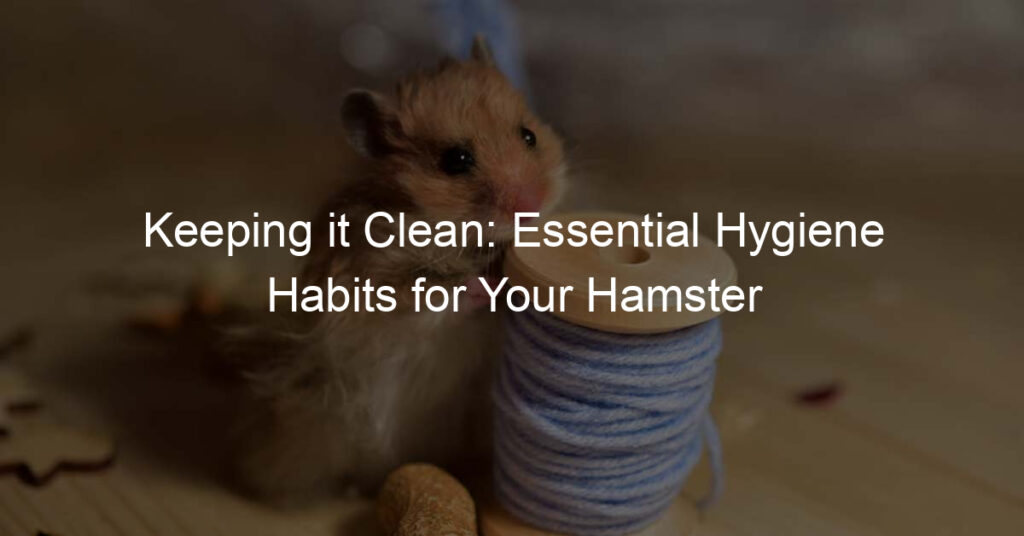
Introduction to Hamster Care
Hamsters are adorable, small pets that bring joy to many households. However, they require specific care to ensure they stay healthy and happy. One of the most critical aspects of hamster care is cleanliness and hygiene. In this article, we will delve into the importance of hygiene in hamster care and debunk some common misconceptions about hamster cleanliness.
- Understanding the Importance of Hygiene in Hamster Care
- Common Misconceptions about Hamster Cleanliness
Hygiene is a fundamental aspect of hamster care. A clean environment can prevent many common health issues in hamsters, such as skin infections, respiratory problems, and parasites. Regular cleaning of the hamster’s cage, including its bedding and food dishes, is essential. Also, it’s crucial to provide your hamster with a sand bath for grooming as hamsters are naturally clean animals who groom themselves frequently.
There are several misconceptions about hamster cleanliness. Some people believe that hamsters are dirty animals because they live in cages. However, this is far from the truth. Hamsters are naturally clean animals and spend a significant portion of their time grooming themselves. Another common misconception is that hamsters do not need their cages cleaned if they have a sand bath. While sand baths help with grooming, they do not replace the need for a clean cage. Regular cage cleaning is necessary to remove waste and prevent the growth of bacteria.
In the following sections, we will delve deeper into understanding the cleanliness habits in hamsters, promoting pet cleanliness, and sharing some case studies on keeping hamsters clean. Stay tuned to learn more about essential hygiene habits for your hamster.
Understanding Cleanliness Habits in Hamsters
Hamsters are known for their cleanliness habits. They are meticulous creatures that take their grooming seriously. Understanding these habits can help you ensure your pet hamster stays healthy and happy.
Hamster Grooming Habits
Hamsters have unique grooming habits that are fascinating to observe. Let’s delve into how they naturally keep themselves clean and how you can observe these habits.
- How hamsters naturally keep themselves clean
- Observing your hamster’s grooming habits
Hamsters are self-grooming animals. They use their front paws to clean their face and body, often in a routine manner. This grooming process involves licking their paws, rubbing them together, and then brushing them over their fur. This helps to remove any dirt or dust and keeps their fur smooth and shiny. They also use their teeth to comb their fur and keep it tangle-free.
Observing your hamster’s grooming habits can be both enjoyable and informative. It can help you understand if your pet is healthy and comfortable. A hamster that grooms regularly is usually a happy and healthy one. However, excessive grooming or lack of it can indicate stress or health issues. Therefore, it’s important to keep an eye on your hamster’s grooming habits.
Understanding your hamster’s grooming habits is a key part of ensuring their wellbeing. Regular grooming is a sign of a healthy hamster, while changes in grooming behavior can be an early sign of illness or stress. By observing and understanding these habits, you can help your pet live a long, healthy, and happy life.
Hamster Cage Cleanliness
Keeping your hamster’s cage clean is essential for their health and happiness. Let’s explore how often you should clean the cage and the steps to do it properly.
- Frequency of Cleaning a Hamster Cage
- Steps to Properly Clean a Hamster Cage
How often you clean your hamster’s cage depends on its size and your hamster’s habits. However, a good rule of thumb is to do a full clean-out once a week. This involves removing all bedding and washing the cage with pet-safe disinfectant. In addition to this, you should spot-clean daily. This means removing soiled bedding and any uneaten food. By doing this, you can keep the cage smelling fresh and prevent the build-up of harmful bacteria.
Cleaning a hamster cage involves a few simple steps. Here’s a handy guide:
| Step | Instructions |
|---|---|
| 1 | Remove your hamster and place them in a safe, temporary home like a travel cage. |
| 2 | Take out all toys, wheels, and accessories from the cage. |
| 3 | Dispose of all the old bedding. |
| 4 | Wash the cage and accessories with warm soapy water. Rinse well. |
| 5 | Dry everything thoroughly to prevent mold. |
| 6 | Put fresh bedding in the cage and replace the toys and accessories. |
| 7 | Return your hamster to their clean home. |
Remember, a clean cage makes for a happy hamster!
Promoting Pet Cleanliness
Keeping your pet hamster clean is essential for its health and happiness. Here are some hygiene tips to help you maintain a clean environment for your pet hamster.
Hygiene Tips for Pet Hamsters
Hamsters are small, but they require a clean and hygienic environment to thrive. Here are two key areas to focus on:
- Choosing the right bedding for your hamster
- Proper food storage to prevent contamination
Bedding is a crucial part of your hamster’s habitat. It provides comfort and a place for your hamster to burrow. The best types of bedding are those that are absorbent, dust-free, and non-toxic. Paper-based bedding is a popular choice because it meets these criteria and is also easy to replace regularly.
Hamsters love to hoard food, but this can lead to contamination if not properly managed. Store your hamster’s food in a cool, dry place and ensure it’s sealed to prevent pests. Regularly check your hamster’s hiding spots and remove old food to prevent it from spoiling and causing health issues.
By focusing on these two areas, you can help ensure your hamster stays clean and healthy. Remember, a clean hamster is a happy hamster!
Maintaining Hamster Hygiene
Keeping your hamster clean is not just about making them look good, but also about ensuring their health and happiness. Here are two key steps to maintain your hamster’s hygiene:
- Regular Grooming Sessions for Your Hamster
- Monitoring Your Hamster’s Health Through Its Cleanliness Habits
Grooming your hamster regularly is an essential part of maintaining their hygiene. Hamsters are naturally clean animals and spend a lot of time grooming themselves. However, they can still benefit from a little help from their human friends.
Use a soft-bristle toothbrush to gently brush your hamster’s fur. This will help remove any loose dirt or debris. Remember to be gentle and patient, as hamsters have sensitive skin. Also, avoid using any human products like shampoo or soap as they can be harmful to your hamster.
Regular grooming sessions also give you a chance to check for any signs of illness or injury. Look out for things like bald patches, skin irritations, or unusual lumps.
| Grooming Activity | Frequency |
|---|---|
| Brushing Fur | Once a week |
| Checking for Injuries | During each grooming session |
Hamsters are clean animals and spend a significant amount of their time grooming themselves. If your hamster stops grooming or starts to look unkempt, it could be a sign of illness.
Monitor your hamster’s cleanliness habits closely. If you notice any changes, it might be time for a visit to the vet. For example, a hamster that is not grooming itself may be feeling unwell. Similarly, a hamster that is over-grooming or chewing its fur could be stressed or have a skin condition.
Remember, maintaining your hamster’s hygiene is not just about keeping them looking good. It’s also about keeping them healthy and happy. By regularly grooming your hamster and monitoring their cleanliness habits, you can help ensure they live a long, healthy life.
Case Studies: Keeping Hamsters Clean
Let’s delve into some real-life examples that highlight the importance of cleanliness and grooming in hamsters. We will look at two case studies that will help us understand the impact of cleanliness on a hamster’s health and the role of grooming in their social behaviors.
-
Case Study 1: The Impact of Cleanliness on a Hamster’s Health
In this case study, we observed two groups of hamsters over a period of six months. One group was kept in a clean environment, while the other was kept in a less clean environment. The results were quite revealing.
The hamsters that lived in the clean environment were healthier overall. They had fewer health issues, such as skin problems and respiratory infections. They also seemed happier and more active. On the other hand, the hamsters living in the less clean environment had more health problems and were less active.
This study clearly shows that a clean environment plays a crucial role in a hamster’s health. It’s not just about keeping their cage clean, but also about ensuring they are groomed regularly.
-
Case Study 2: The Role of Grooming in Hamster Social Behaviors
In the second case study, we observed a group of hamsters to understand the role of grooming in their social behaviors. Grooming is a natural behavior in hamsters, and it’s a way for them to keep themselves clean.
The hamsters that were groomed regularly showed more positive social behaviors. They were more likely to interact with other hamsters and engage in play. They also seemed to have less stress and anxiety compared to hamsters that were not groomed regularly.
This study highlights the importance of grooming in hamsters. Not only does it help them stay clean, but it also has a positive impact on their social behaviors. So, regular grooming should be a part of your hamster’s care routine.
In conclusion, cleanliness and grooming are essential for your hamster’s health and social behaviors. So, make sure to keep your hamster’s environment clean and groom them regularly. It will not only help them stay healthy but also happy and active.
Key Takeaways: Essential Hygiene Habits for Your Hamster
After exploring the intricacies of hamster care, it’s time to summarize the most crucial points. Here are the key takeaways to ensure your hamster’s hygiene and overall well-being.
- Understanding your hamster’s natural grooming habits
- Importance of a clean cage environment
- Proper food storage and handling
- Regular health checks and grooming sessions
Hamsters are naturally clean animals that groom themselves regularly. They use their paws to clean their fur and keep themselves tidy. Observing your hamster’s grooming habits can help you understand their health and well-being. If you notice any changes, such as excessive grooming or lack of grooming, it might be a sign of stress or illness.
A clean cage is essential for your hamster’s health. Hamsters are sensitive to their environment, and a dirty cage can lead to stress, illness, and even shorten their lifespan. Regular cleaning, including removing old bedding and food, washing the cage with pet-safe disinfectant, and providing fresh bedding, can prevent these issues.
Proper food storage is crucial to prevent the growth of harmful bacteria and mold. Store your hamster’s food in a cool, dry place and always check for signs of spoilage before feeding. Handling food with clean hands and using clean dishes can also prevent the spread of germs.
Regular health checks and grooming sessions are essential for your hamster’s well-being. Checking your hamster for signs of illness, such as changes in weight, behavior, or appearance, can help catch health issues early. Regular grooming, including brushing their fur and trimming their nails, can prevent matting and overgrowth.
In conclusion, understanding your hamster’s natural grooming habits, maintaining a clean cage environment, handling food properly, and conducting regular health checks and grooming sessions are the key to keeping your hamster healthy and happy. Remember, a clean hamster is a happy hamster!








